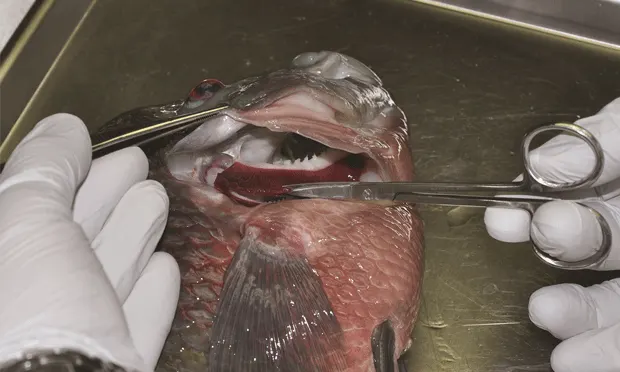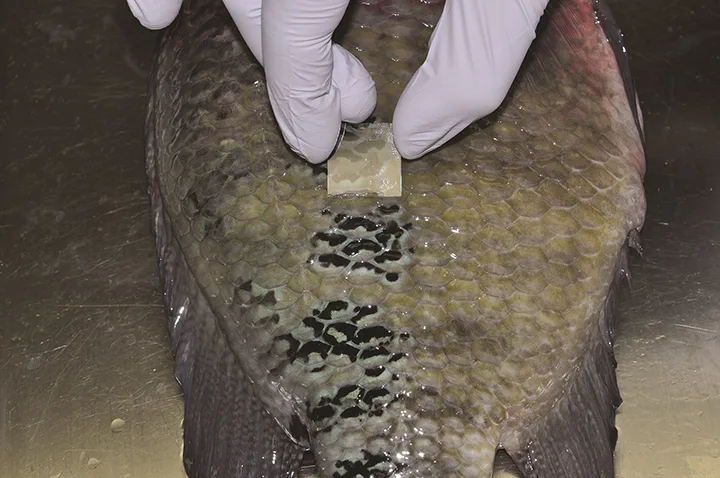Skills for Technicians: The Basics of Pet Fish Medicine

Ornamental fish are the third most commonly kept pets in the United States1 and are increasingly presented to veterinarians for evaluation and treatment of diseases. Veterinary technicians play an important role in evaluating and treating these patients.
Transportation
Ornamental fish owners should be instructed how to properly transport fish to the practice because minimizing stress during transport is important. Pet fish can be placed in plastic (polyethylene) bags filled one-third with water and two-thirds with room air or carried in plastic containers or buckets. They should also be protected from sudden temperature changes and remain in the dark. Also, in addition to the water in the transport container, clients should be instructed to bring extra water to be used for water testing, for transportation following the appointment, and/or for recovery after an anesthetic procedure.
History Collection
Veterinary technicians should be knowledgeable about the basics of fish husbandry and standard equipment used (eg, aquarium filtration types, aeration, heaters) as well as the basics of water quality. They should also be familiar with commonly used equipment sold in pet stores and online to ask appropriate questions during history collection.
Basic History Collection List for Ornamental Fish Housed in Tank
Environment
Fresh or saltwater tank
Size and volume of tank
Species, number, and size of fish in tank
Age of established tank
Live or artificial plants
Most recent introduction of live plants or fish
Location of tank
Substrate (size, layer thickness)
Filtration system (eg, filter type [internal/external], filter media
Temperature and temperature monitoring
Lighting
Water quality
Source of water
Dechlorination technique used
Water testing performed
Regular water changes and tank cleaning schedule
Feeding (eg, type, frequency, amount)
Patient-specific History
Age of fish (eg, duration of ownership)
Duration of presenting complaint
Previous medical history
Appetite and activity
Water Quality Assessment
Environmental assessment is an important part of the evaluation of fish patients and basic water quality testing should be performed whenever possible. Basic water quality test kits are readily available. Clients should be instructed to bring water for evaluation to the appointment in a separate container in which no fish are transported. Water quality parameters evaluated routinely should include:
pH
Ammonia
Nitrate
Nitrite
Alkalinity
Hardness
Additionally, dissolved oxygen, salinity, and chlorine/chloramines can be measured.
Visual Patient Assessment
An initial visual assessment should be performed. Evaluate the following:
Fish’s position in water column
Behavior (eg, gasping)
Orientation
Swimming behavior (eg, circling, drifting)
Reaction to external stimuli
Opercular (gill cover) movements
Body condition
Distention of the abdomen (may be caused by ascites, bloat, organomegaly, generalized edema, coelomic mass, obesity, or polycystic kidneys)
Eye condition (eg, exophthalmos, enopthalmos, cataracts)
Gill condition (eg, anemic, hemorrhagic, necrotic, fungus, parasites); may also need a gill biopsy and cytology
Skin lesions (eg, ulcers, white spots, increased mucus, erythema)
Tail and fin condition (frayed, erythema, parasites)
Anal opening (fecal retention, inflammation, prolapse)
Direct Physical Examination
A physical examination should be performed after the fish has been removed from the water. Do not restrain fish without wearing disposable gloves to minimize possible zoonotic disease transmission and to avoid damage to the fish’s skin.
Manual restraint may be sufficient for brief physical examinations and diagnostic sample collection, but sedation is preferable, particularly for larger fish or if several diagnostic procedures are planned (eg, blood collection). For sedation, MS-222, TMS, tricaine methanesulfonate (Tricane-S, Western Chemical, wchemical.com) is FDA-approved for immobilization of fish. Routinely a 10 g/L stock solution is prepared, which should be buffered (v/v) with sodium bicarbonate. Dose-dependent levels of sedation or anesthesia can be achieved with dosages ranging from 15–150 mg/L administered by bath. Reversal of the sedation/anesthesia is accomplished by placing the fish in water without the immobilization agent.
Common clinical diagnostic procedures routinely performed in fish include skin scrapings (Figure 1) and gill or fin biopsies (Figures 2 & 3) for cytologic examination as well as blood collection and diagnostic imaging.

Figure 1. Skin scraping (mucous smear)
Use a coverslip, microscope slide edge, or blunt edge of a scalpel blade to superficially scrape in a cranial–caudal direction. Avoid excessive pressure during the sample collection to avoid trauma to the underlying skin. Transfer the harvested mucous sample to a microscope slide, add a drop of tank water, and cover with a cover slip. Examine the wet-mount preparation immediately for ectoparasites, fungi, and bacteria.
Conclusion
Veterinary technicians may not see pet fish frequently, but knowing these basics will make them feel confident when they do.